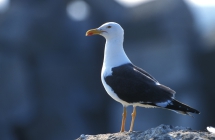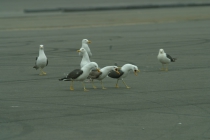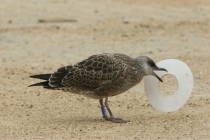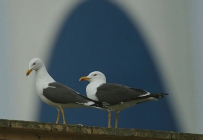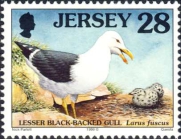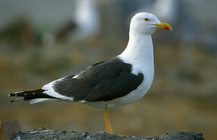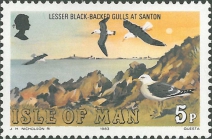RAS taxon details
Larus fuscus Linnaeus, 1758
137142 (urn:lsid:marinespecies.org:taxname:137142)
accepted
Species
marine, terrestrial
Linnaeus, C. (1758). Systema Naturae per regna tria naturae, secundum classes, ordines, genera, species, cum characteribus, differentiis, synonymis, locis. [The system of nature through the three kingdoms of nature, according to classes, orders, genera, species, with characters, differences, synonyms, places.]. <em>Impensis Direct. Laurentii Salvii. Holmiae [Stockholm].</em> 1(10) [iii], 824 p., available online at https://biodiversitylibrary.org/page/726886
page(s): 136 [details] Available for editors
page(s): 136 [details] Available for editors
RAS (2021). Larus fuscus Linnaeus, 1758. Accessed at: http://ras.biodiversity.aq/aphia.php?p=taxdetails&id=137142 on 2025-04-26
RAS (Eds.) (2025). Register of Antarctic Species. Larus fuscus Linnaeus, 1758. Accessed at: https://ras.biodiversity.aq/aphia.php?p=taxdetails&id=137142 on 2025-04-26
Date
action
by
original description
Linnaeus, C. (1758). Systema Naturae per regna tria naturae, secundum classes, ordines, genera, species, cum characteribus, differentiis, synonymis, locis. [The system of nature through the three kingdoms of nature, according to classes, orders, genera, species, with characters, differences, synonyms, places.]. <em>Impensis Direct. Laurentii Salvii. Holmiae [Stockholm].</em> 1(10) [iii], 824 p., available online at https://biodiversitylibrary.org/page/726886
page(s): 136 [details] Available for editors
context source (HKRMS) HKBWS. (2013). Hong Kong Bird Report 2011. <em>The Hong Kong Bird Watching Society.</em> [details]
context source (Schelde) Maris, T., O. Beauchard, S. Van Damme, E. Van den Bergh, S. Wijnhoven & P. Meire. (2013). Referentiematrices en Ecotoopoppervlaktes Annex bij de Evaluatiemethodiek Schelde-estuarium Studie naar “Ecotoopoppervlaktes en intactness index”. [Reference matrices and Ecotope areas Annex to the Evaluation methodology Scheldt estuary Study on “Ecotope areas and intactness index”. <em>Monitor Taskforce Publication Series, 2013-01. NIOZ: Yerseke.</em> 35 pp. (look up in IMIS) [details]
context source (BeRMS 2020) Research Institute for Nature and Forest (INBO). European Seabirds at Sea - data collected by the Research Institute for Nature and Forest (INBO). INBO Seabird distribution data (all trips). [details]
context source (Bermuda) Amos, E. J. R. (1991). A Guide to The Birds of Bermuda. 206 pp [details]
basis of record van der Land, J. (2001). Tetrapoda, <B><I>in</I></B>: Costello, M.J. <i>et al.</i> (Ed.) (2001). <i>European register of marine species: a check-list of the marine species in Europe and a bibliography of guides to their identification. Collection Patrimoines Naturels,</i> 50: pp. 375-376 (look up in IMIS) [details]
additional source Banks, R.C., R.W. McDiarmid, and A.L. Gardner. 1987. Checklist of vertebrates of the United States, the U.S. Territories, and Canada. U.S. Fish and Wildlife Service Resource Publication No. 166. 79 p. [details]
additional source Robbins, C. S. (1983). Golden field Guide to Birds of North America. Golden press. 360p. [details]
additional source Peterson, R.T.; Peterson, V.M. (2002). A field guide to the birds of eastern and central North America. <em>Fifth Edition.</em> Peterson Field Guide Series. Houghton Mifflin Company. New York. 427 p. [details]
additional source Squires, H. J. (1990). Decapod Crustacea of the Atlantic coast of Canada. <em>Canadian Bulletin of Fisheries and Aquatic Sciences.</em> 221: 532 p., available online at http://www.dfo-mpo.gc.ca/library/116743.pdf [details]
additional source Urban, E. K.; Fry, C. H.; Keith, S. (1986). The Birds of Africa, Volume II. <em>Academic Press, London.</em> [details]
additional source Muller, Y. (2004). Faune et flore du littoral du Nord, du Pas-de-Calais et de la Belgique: inventaire. [Coastal fauna and flora of the Nord, Pas-de-Calais and Belgium: inventory]. <em>Commission Régionale de Biologie Région Nord Pas-de-Calais: France.</em> 307 pp., available online at http://www.vliz.be/imisdocs/publications/145561.pdf [details]
additional source Vanderperren, J.-P. (1991). Report Natural History Archive 1990 [Verslag Natuurhistorisch Archief 1990]. <em>De Strandvlo.</em> 11(3): 65-75. (look up in IMIS)
page(s): 71 [details]
additional source Gallardo, J. C.; Macías, V.; Velarde, E. (2009). Birds (Vertebrata: Aves) of the Gulf of Mexico. <em>In: Felder, D.L. and D.K. Camp (eds.), Gulf of Mexico–Origins, Waters, and Biota. Biodiversity. Texas A&M Press, College Station, Texas.</em> Pp. 1321–1342. [details]
additional source Liu, J.Y. [Ruiyu] (ed.). (2008). Checklist of marine biota of China seas. <em>China Science Press.</em> 1267 pp. (look up in IMIS) [details] Available for editors
additional source Cattrijsse, A. & M. Vincx. (2001). Biodiversity of the benthos and the avifauna of the Belgian coastal waters: summary of data collected between 1970 and 1998. <em>Federal Office for Scientific, Technical and Cultural Affairs: Brussel, Belgium.</em> 48 pp. (look up in IMIS) [details]
page(s): 136 [details] Available for editors
context source (HKRMS) HKBWS. (2013). Hong Kong Bird Report 2011. <em>The Hong Kong Bird Watching Society.</em> [details]
context source (Schelde) Maris, T., O. Beauchard, S. Van Damme, E. Van den Bergh, S. Wijnhoven & P. Meire. (2013). Referentiematrices en Ecotoopoppervlaktes Annex bij de Evaluatiemethodiek Schelde-estuarium Studie naar “Ecotoopoppervlaktes en intactness index”. [Reference matrices and Ecotope areas Annex to the Evaluation methodology Scheldt estuary Study on “Ecotope areas and intactness index”. <em>Monitor Taskforce Publication Series, 2013-01. NIOZ: Yerseke.</em> 35 pp. (look up in IMIS) [details]
context source (BeRMS 2020) Research Institute for Nature and Forest (INBO). European Seabirds at Sea - data collected by the Research Institute for Nature and Forest (INBO). INBO Seabird distribution data (all trips). [details]
context source (Bermuda) Amos, E. J. R. (1991). A Guide to The Birds of Bermuda. 206 pp [details]
basis of record van der Land, J. (2001). Tetrapoda, <B><I>in</I></B>: Costello, M.J. <i>et al.</i> (Ed.) (2001). <i>European register of marine species: a check-list of the marine species in Europe and a bibliography of guides to their identification. Collection Patrimoines Naturels,</i> 50: pp. 375-376 (look up in IMIS) [details]
additional source Banks, R.C., R.W. McDiarmid, and A.L. Gardner. 1987. Checklist of vertebrates of the United States, the U.S. Territories, and Canada. U.S. Fish and Wildlife Service Resource Publication No. 166. 79 p. [details]
additional source Robbins, C. S. (1983). Golden field Guide to Birds of North America. Golden press. 360p. [details]
additional source Peterson, R.T.; Peterson, V.M. (2002). A field guide to the birds of eastern and central North America. <em>Fifth Edition.</em> Peterson Field Guide Series. Houghton Mifflin Company. New York. 427 p. [details]
additional source Squires, H. J. (1990). Decapod Crustacea of the Atlantic coast of Canada. <em>Canadian Bulletin of Fisheries and Aquatic Sciences.</em> 221: 532 p., available online at http://www.dfo-mpo.gc.ca/library/116743.pdf [details]
additional source Urban, E. K.; Fry, C. H.; Keith, S. (1986). The Birds of Africa, Volume II. <em>Academic Press, London.</em> [details]
additional source Muller, Y. (2004). Faune et flore du littoral du Nord, du Pas-de-Calais et de la Belgique: inventaire. [Coastal fauna and flora of the Nord, Pas-de-Calais and Belgium: inventory]. <em>Commission Régionale de Biologie Région Nord Pas-de-Calais: France.</em> 307 pp., available online at http://www.vliz.be/imisdocs/publications/145561.pdf [details]
additional source Vanderperren, J.-P. (1991). Report Natural History Archive 1990 [Verslag Natuurhistorisch Archief 1990]. <em>De Strandvlo.</em> 11(3): 65-75. (look up in IMIS)
page(s): 71 [details]
additional source Gallardo, J. C.; Macías, V.; Velarde, E. (2009). Birds (Vertebrata: Aves) of the Gulf of Mexico. <em>In: Felder, D.L. and D.K. Camp (eds.), Gulf of Mexico–Origins, Waters, and Biota. Biodiversity. Texas A&M Press, College Station, Texas.</em> Pp. 1321–1342. [details]
additional source Liu, J.Y. [Ruiyu] (ed.). (2008). Checklist of marine biota of China seas. <em>China Science Press.</em> 1267 pp. (look up in IMIS) [details] Available for editors
additional source Cattrijsse, A. & M. Vincx. (2001). Biodiversity of the benthos and the avifauna of the Belgian coastal waters: summary of data collected between 1970 and 1998. <em>Federal Office for Scientific, Technical and Cultural Affairs: Brussel, Belgium.</em> 48 pp. (look up in IMIS) [details]
 Present
Present  Inaccurate
Inaccurate  Introduced: alien
Introduced: alien  Containing type locality
Containing type locality
| Language | Name | |
|---|---|---|
| English | lesser black-backed gull | [details] |
